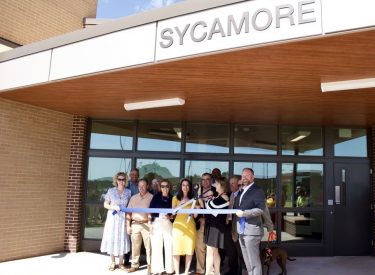OJA’s Next Generation Campus Officially Open
Oklahoma Office of Juvenile Affairs - June 28, 2022 6:11 am

Cutting a ribbon to officially open the Central Oklahoma Juvenile Center Next Generation Campus are Office of Juvenile Affairs (OJA) Executive Director Rachel Holt, left, and OJA Board Chair Karen Youngblood.
TECUMSEH – Officials with the Office of Juvenile Affairs (OJA) today officially opened a state-of-the art therapeutic campus for young people requiring secure care treatment.
The Next Generation Campus was built on the grounds of the Central Oklahoma Juvenile Center (COJC) in Tecumseh. The campus, which is designed to accommodate up to 144 youth, includes a new health clinic/intake center and new residential cottages featuring ample natural light. The seven cottages have high-ceiling dayrooms, and each resident has a bedroom with a window. Units at COJC previously were open-dorm style with very little natural lighting.
The new campus also offers space and landscaping designed for walking and talking.
Improvements were made to the education/gymnasium building and to the administration building. Several outdated buildings, some a century old, were demolished.
“The Next Generation Campus is the first time the state invested to build from scratch residential cottages and other structures specifically for this population,” said OJA Executive Director Rachel Holt. “This is a gift to OJA, to our staff and to the youth we serve every day.
“OJA does not take this gift lightly, being given these resources and investment is a charge to us to use these resources and opportunities to improve services and outcomes and satisfaction for our residents and our staff. I say often that as we complete this construction project, Oklahoma will lead the nation in the physical structure for secure care, but we also want and we will lead the nation in the treatment and services that occur within these light, bright spaces and the attitudes and outcomes not only for our residents but also our dedicated staff.”
“This project was undertaken in stages, all the while the Central Oklahoma Juvenile Center was open and continuing to provide services to youth,” said Karen Youngblood, chair of OJA’s board. “Old, deteriorating buildings were torn down, a couple will be refurbished, and new residential cottages and a new clinic/intake center were built. This modern campus not only facilitates effective treatment for our residents, but promotes safety for our staff.
“As a result of having one centralized facility, OJA is addressing technology inefficiencies, improving medical and treatment services, providing equitable education for all youth placed in secure facilities, and saving money in transportation and travel.”
Operations continued at COJC while the Next Generation Campus was being developed. Construction started in August 2019. The project was funded primarily by a $45 million bond.
In 2017, legislation was approved authorizing up to $45 million in bonds to help the agency consolidate its secure-care operations in an updated facility in Tecumseh. The agency is funding the project with money that it has saved through efficiencies. In 2018, OJA closed its facility for females in Norman and secure care operations at Southwestern Oklahoma Juvenile Center in Manitou will be moved to Tecumseh later this year.
COJC is on 40 acres of a nearly 150-acre plat and has long needed an update. The campus first opened in 1907 and has gone through many transformations over the years. Previously, it was known as the Russell Industrial School, Oklahoma State Industrial School for Incorrigible Girls, the State Industrial School for White Girls, Girls Town and the Central Oklahoma Juvenile Treatment Center.
At various times, it has housed orphans, children in need of mental health treatment, and youth adjudicated as delinquent and/or youthful offenders.
“The residents at this level of care are at the deepest end of the juvenile justice system,” Holt said. “This is the stop that we try to keep them from through early prevention, court diversion and probation in the community and lower levels of out-of-home placements in our contracted group homes. This is the last stop in the juvenile justice continuum and our residents here have the highest levels of crime, risks, needs and are most likely to have poor outcomes.
“Through the state’s investment in this physical space, we are telling these kids that the state believes in them, believes in their treatment, believes in their future.”



